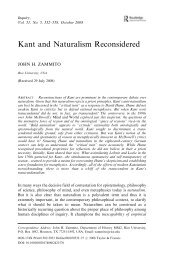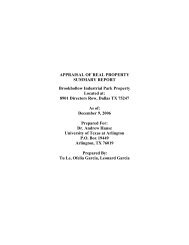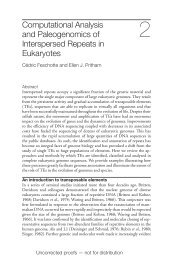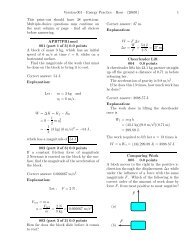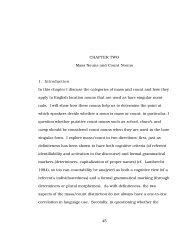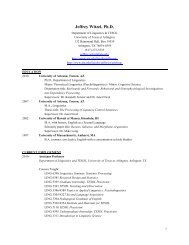Low Rank ADI Solution of Sylvester Equation via Exact Shifts
Low Rank ADI Solution of Sylvester Equation via Exact Shifts
Low Rank ADI Solution of Sylvester Equation via Exact Shifts
Create successful ePaper yourself
Turn your PDF publications into a flip-book with our unique Google optimized e-Paper software.
<strong>Low</strong> <strong>Rank</strong> <strong>ADI</strong> <strong>Solution</strong> <strong>of</strong><strong>Sylvester</strong> <strong>Equation</strong> <strong>via</strong> <strong>Exact</strong><strong>Shifts</strong>Ninoslav TruharZoran TomljanovicRen-Cang LiTechnical Report 2009-03http://www.uta.edu/math/preprint/
1 IntroductionIn this paper we consider the properties <strong>of</strong> the solution <strong>of</strong> m × n <strong>Sylvester</strong>equationAX − XB = C, (1.1)where A, B, and C are m × m, n × n, and m × n, respectively, and unknownmatrix X is m × n. <strong>Equation</strong> (1.1) has a unique solution if and only if A andB have no common eigenvalues, which will be assumed throughout this paper.<strong>Sylvester</strong> equations appear frequently in many areas <strong>of</strong> applied mathematics.We refer the reader to the elegant survey by Bhatia and Rosenthal [12]and references therein for a history <strong>of</strong> the equation and many interesting andimportant theoretical results. <strong>Sylvester</strong> equations are important in a number<strong>of</strong> applications such as matrix eigen-decompositions [21,41], control theory[16,32,41], model reduction [1,2,8,43], numerical solution <strong>of</strong> matrix differentialRiccati equations [15,17,19], and many more.There are several numerical algorithms for calculation <strong>of</strong> the solution <strong>of</strong> <strong>Sylvester</strong>equations. The standard ones are the Bartels-Stewart algorithm [6] and theHessenberg-Schur method first described by Enright [19], but more <strong>of</strong>ten attributedto Golub, Nash, and Van Loan [20]. Another computationally efficientapproach for the case that both A and −B are (Hurwitz) stable, i.e., have alltheir eigenvalues in the open left half plane, is the sign function method [38].All these methods are efficient for dense matrices A and B.However, recent interest is directed more towards large and sparse matricesA and B, and C = GF ∗ with very low rank, where G and F haveonly a few columns. For dense A, B, an approach based on the sign functionmethod is suggested in [9] that exploits the low-rank structure <strong>of</strong> C. Thisapproach is further used in [7] in order to solve large-scale <strong>Sylvester</strong> equationswith data-sparse A, B, i.e., dense matrices A, B that can be representedby O(n log(n)) data. Common methods for sparse A, B are Krylov subspacebased algorithms [4,5,18,25–30,39,40,42] and Alternating-Directional-Implicit(<strong>ADI</strong>) iterations [10,22,31,33,34,36,49].On the other hand, the problem <strong>of</strong> the sensitivity <strong>of</strong> the solution <strong>of</strong> the<strong>Sylvester</strong> equation is also widely studied problem. There are several bookswhich contains results about this, e.g., [37,23,45].Our main concern is how would the solution behaves when C is a low rank matrix.Our investigation is through applying <strong>Low</strong>-rank Alternating-Directional-Implicit method (LR-<strong>ADI</strong>) with exact shifts, i.e., all or part <strong>of</strong> the eigenvalues<strong>of</strong> A and B.Our results show that the right-hand side <strong>of</strong> <strong>Sylvester</strong> equation can sometimes2
greatly influence the norm <strong>of</strong> X and how it changes in the face <strong>of</strong> perturbations.The bound on the norm <strong>of</strong> X can be considered as a proper generalization <strong>of</strong>the results from [48].Notation. Throughout this paper, C n×m is the set <strong>of</strong> all n × m complexmatrices, C n = C n×1 , and C = C 1 . Similarly define R n×m , R n , and R exceptreplacing the word complex by real. I n (or simply I if its dimension is clearfrom the context) is the n × n identity matrix, and e j is its jth column. Thesuperscript “·∗” takes conjugate transpose while “·T” takes transpose only. Weshall also adopt MATLAB-like convention to access the entries <strong>of</strong> vectors andmatrices. i : j is the set <strong>of</strong> integers from i to j inclusive and i : i = {i}. Fora vector u and a matrix X, u (j) is u’s jth entry, X (i,j) is X’s (i, j)th entry;X’s submatrices X (k:l,i:j) , X (k:l,:) , and X (:,i:j) consist <strong>of</strong> intersections <strong>of</strong> row kto row l and column i to column j, row k to row l, and column i to columnj, respectively. ‖ · ‖ and ‖ · ‖ F stands for the spectral norm and the Frobeniusnorm <strong>of</strong> a matrix, respectively. κ(A) = ‖A‖ ‖A −1 ‖ is the spectral conditionnumber <strong>of</strong> A.2 <strong>Low</strong> rank <strong>ADI</strong> for <strong>Sylvester</strong> <strong>Equation</strong>Our first result is a generalization <strong>of</strong> the main results from [48] where some newestimates for the eigenvalue decay rate <strong>of</strong> the Lyapunov equation AX+XA T =C with a low rank right-hand side C has been derived. Our main result will bea bound on the norm <strong>of</strong> the solution <strong>of</strong> the following m × n <strong>Sylvester</strong> equationAX − XB = GF ∗ , (2.1)where A, B, G and F are m × m, n × n, m × r and n × r, respectively, andunknown matrix X is m × n. It is assumed r ≪ min{m, n}.But before we continue, we will briefly describe the <strong>Low</strong>-rank Alternating-Directional-Implicit (LR-<strong>ADI</strong>) method for solving <strong>Sylvester</strong> equation (2.1)(more details can be found in [47] or [11]).Given two sets <strong>of</strong> parameters {α i } and {β i }, <strong>ADI</strong> iteration for iterativelysolving (2.1) goes as follows: For i = 0, 1, . . .,(1) solve (A − β i I)X i+1/2 = X i (B − β i I) + C for X i+1/2 ;(2) solve X i+1 (B − α i I) = (A − α i I)X i+1/2 − C for X i+1 ,for an initial guess X 0 which is assumed to be 0 in this paper. A ratherstraightforward implementation for <strong>ADI</strong> can be given based on this.Note that parameters {α i } and {β i } in (LR-<strong>ADI</strong>) method for solving <strong>Sylvester</strong>3
equation (2.1) should be chosen such that α i ≠ β i , for all i. In the case <strong>of</strong>Lyapunov equation AX + XA T = C with the stable matrix A parameters{α i } should be chosen such that Re(α i ) < 0 and β i = −α i for all i, whereRe(z) denotes real part <strong>of</strong> z.Expressing X i+1 in terms <strong>of</strong> X i , we have 2X i+1 = (β i − α i )(A − β i I) −1 C(B − α i I) −1and the error equation+(A − α i I)(A − β i I) −1 X i (B − β i I)(B − α i I) −1 ,X i+1 − X = (A − α i I)(A − β i I) −1 (X i − X)(B − β i I)(B − α i I) −1 ,⎡⎤⎡⎤i∏i∏= ⎣ (A − α j I)(A − β j I) −1 ⎦ (X 0 − X) ⎣ (B − β j I)(B − α j I) −1 ⎦ ,j=0where X denotes the exact solution. If convergence occurs much earlier inthe sense that it takes much fewer than min{m, n}/r steps, then <strong>ADI</strong> in thefactored form as below would be more economical. Let X i = Z i D i Yi ∗ . We havej=0(2.2)where)X i+1 =((A − β i I) −1 G (A − α i I)(A − β i I) −1 Z i ×⎛⎜ (β i − α i )I⎝D i⎞⎟⎠ ×⎛⎞⎜ F ∗ (B − α i I) −1 ⎟⎝⎠Yi ∗ (B − β i I)(B − α i I) −1≡ Z i+1 D i+1 Y ∗i+1,2 It can be also gotten from the identity(A − βI)X(B − αI) − (A − αI)X(B − βI) = (β − α)C.4
)Z i+1 =((A − β i I) −1 G (A − α i I)(A − β i I) −1 Z i ,⎛⎞⎜D i+1 =(β i − α i )I ⎟⎝ ⎠ ,D i⎛⎜ F ∗ (B − α i I) −1 ⎟⎝⎠ .Yi+1 ∗ =Y ∗i (B − β i I)(B − α i I) −1 ⎞After renaming the parameters {α i } and {β i } as in [47] or [11], since Z 0 = 0and Y 0 = 0, we can write,)Z k =(Z (1) Z (2) · · · Z (k) ,⎧Z⎪⎨(1) = (A − β 1 I) −1 G,(2.3)with Z (i+1) = (A − α i I)(A − β i+1 I) −1 Z (i)and Y k =⎪⎩(Y (1) Y (2) · · · Y (k) ),= Z (i) + (β i+1 − α i )(A − β i+1 I) −1 Z (i) ,with⎧Y (1)∗ = F ∗ (B − α 1 I) −1 ,⎪⎨Y (i+1)∗ = Y (i)∗ (B − α i+1 I) −1 (B − β i I)(2.4)⎪⎩= Y (i)∗ + (α i+1 − β i )Y (i)∗ (B − α i+1 I) −1 .All together giveX k = Z k D k Y ∗k , D k = diag ((β 1 − α 1 )I, . . . , (β k − α k )I) ,ork∑X k = (β j − α j )Z (j) Y (j)∗ . (2.5)j=13 The diagonalizable caseIn this section we will present an upper bound for the norm <strong>of</strong> the solution <strong>of</strong><strong>Sylvester</strong> equation (2.1) for diagonalizable matrices A and B, an error boundfor the kth LR-<strong>ADI</strong> solution with exact shifts, and a first order perturbationbound when A, B, G, and F are perturbed slightly.5
Suppose A and B are diagonalizable, i.e.,A = SΛS −1 , Λ = diag(λ 1 , . . . , λ m ), (3.1)B = T ΩT −1 , Ω = diag(µ 1 , . . . , µ n ). (3.2)Then the (i + 1)st block <strong>of</strong> Z k and Y ∗kcan be written asZ (i+1) = S(Λ − α i I)(Λ − β i+1 I) −1 S −1 Z (i) , (3.3)Y (i+1)∗ = Y (i)∗ T (Ω − α i+1 I) −1 (Ω − β i I)T −1 . (3.4)Define∆ i = (Λ − α i I)(Λ − β i I) −1 , (∆ i ) (j,j) = λ j − α iλ j − β i,Θ i = (Ω − β i I)(Ω − α i I) −1 , (Θ i ) (j,j) = µ j − β iµ j − α i.<strong>Equation</strong>s (3.3) and (3.4) implyZ (i+1) = S(Λ − α i I)(Λ − β i+1 I) −1 (Λ − α i−1 I)(Λ − β i I) −1 · · ·· · · (Λ − α 1 I)(Λ − β 2 I) −1 (Λ − β 1 I) −1 S −1 G= S(Λ − β i+1 I) −1 ∆ i ∆ i−1 · · · ∆ 1 S −1 G,Y (i+1)∗ = F ∗ T (Ω − α 1 I) −1 (Ω − α 2 I) −1 (Ω − β 1 I) · · ·· · · (Ω − α i+1 I) −1 (Ω − β i I)T −1= F ∗ T Θ 1 Θ 2 · · · Θ i (Ω − α i+1 I) −1 T −1 .Notice (Λ − β i+1 I) −1 ∆ i ∆ i−1 · · · ∆ 1 is diagonal with its jth diagonal entry((Λ − βi+1 I) −1 ∆ i ∆ i−1 · · · ∆ 1)(j,j) = i∏l=1λ j − α l 1· ,λ j − β l λ j − β i+1and similarly Θ 1 Θ 2 · · · Θ i (Ω − α i+1 I) −1 is also diagonal with its jth diagonalentry(Θ1 Θ 2 · · · Θ i (Ω − α i+1 I) −1) (j,j) = i∏l=1µ j − β l 1· ,µ j − α l µ j − α i+1Our first theorem gives an upper bound for the norm <strong>of</strong> the solution <strong>of</strong><strong>Sylvester</strong> equation (2.1). But before we state the first theorem, we note that(2.2) implies that if {α j } i j=0 contains all <strong>of</strong> A’s eigenvalues (multiple eigenvaluescounted as many times as their algebraic multiplicities) or if {β j } i j=0contains all <strong>of</strong> B’s eigenvalues, then X i+1 − X ≡ 0. This is because, bythe Cayley-Hamilton theorem, p(A) ≡ 0 for A’s characteristic polynomial6
p(λ) def = det(λI − A) and q(B) ≡ 0 for q(λ) def = det(λI − B). Choose parameterssuch thateither α i = λ pi for i = 1, . . . , m, or β j = µ qj for j = 1, . . . , n,where {p i } and {q j } denote some permutations <strong>of</strong> indices 1, . . . , m and 1, . . . , n,respectively. Then the solution X <strong>of</strong> the <strong>Sylvester</strong> equation (2.1) can be writtenas⎛⎞∑n 0X ≡ X n0 = S ⎝ (µ qj − λ pj )Φ (j) Ψ (j) ⎠ T −1 , n 0 = min{m, n}, (3.5)j=1whereandΦ (j) = diagσ(i, j − 1) =( )σ(1, j − 1) σ(m, j − 1), . . . , S −1 G, (3.6)λ 1 − µ qj λ m − µ qjj−1 ∏s=1Ψ (j) = F ∗ T diagτ(i, j − 1) =j−1 ∏s=1λ i − λ psλ i − µ qs, σ(i, 0) = 1, i = 1, . . . , m, (3.7)( )τ(1, j − 1) τ(n, j − 1), . . . , , (3.8)µ 1 − λ pj µ n − λ pjµ i − µ qsµ i − λ ps, τ(i, 0) = 1, i = 1, . . . , n.Before we state our first result, we like to emphasize that equation (3.5) is aproper generalization <strong>of</strong> the similar equation for the solution <strong>of</strong> the Lyapunovequation from [48]. It is obtained as a by-product <strong>of</strong> the <strong>ADI</strong> Method for<strong>Sylvester</strong> <strong>Equation</strong>s from [11] or [47]. A similar equation to (3.5) can alsobe obtained using the eigenvalue decompositions <strong>of</strong> A and B and the LUdecomposition <strong>of</strong> the corresponding Cauchy matrix presented in [13].Now, we can state our first result.Theorem 3.1 Assume A and B have eigen-decompositions (3.1) and (3.2).Let X be the solution <strong>of</strong> the <strong>Sylvester</strong> equation (2.1). Then the following inequality‖X‖ ≤ ‖S‖‖T −1 ∑n 0m∑ |σ(i, j − 1)| · ‖ĝ i ‖n∑ |τ(l, j − 1)| ‖‖ |µ qj − λ pj |ˆf l ‖,j=1i=1|λ i − µ qj |l=1|µ l − λ pj |(3.9)holds, where σ(·, ·) and τ(·, ·) are defined as in (3.6) and (3.8), respectively,and ĝ i , ˆf l denote the ith row <strong>of</strong> Ĝ = S−1 G and the lth column <strong>of</strong> ˆF ∗ = F ∗ T ,respectively.7
Pro<strong>of</strong>. The pro<strong>of</strong> simply follows after taking the norms <strong>of</strong> the both sides <strong>of</strong>(3.5) and using (3.6) and (3.8). ✷Remark 3.1 Note that in the bound from Theorem 3.1 we combined each <strong>of</strong> Gand F ∗ together with eigenvectors matrices <strong>of</strong> A and B. This approach has twoadvantages. First, if certain eigenvectors <strong>of</strong> A are nearly linearly dependent,then it is straightforward to see that for some G it is possible ‖S −1 G‖ ≪‖S −1 ‖‖G‖. On the other hand if for some i, numbers σ(i,j−1)λ i −µ qjare large andcorresponding ‖ĝ i ‖ are small, then again it is possiblem∑i=1|σ(i, j − 1)| · ‖ĝ i ‖|λ i − µ qj |≪ maxiσ(i, j − 1)|λ i − µ qj | · ‖S−1 G‖ .3.1 Error BoundsIn this section we are going to present an upper bound for the approximation<strong>of</strong> the solution <strong>of</strong> <strong>Sylvester</strong> equation (2.1).Theorem 3.2 Assume A and B have eigen-decompositions (3.1) and (3.2).Let X k be the kth approximation obtained by (2.3) – (2.5) with the set <strong>of</strong> <strong>ADI</strong>parameters corresponding to some subset <strong>of</strong> exact eigenvalues <strong>of</strong> A and B, i.e.{α 1 , α 2 , . . . , α k } = {λ p1 , λ p2 , . . . , λ pk } and {β 1 , β 2 , . . . , β k } = {µ q1 , µ q2 , . . . , µ qk }.Then the following inequality‖X−X k ‖ ≤ ‖S‖‖T −1 ‖n 0 ∑j=k+1|µ qj −λ pj |m∑i=1|σ(i, j − 1)| · ‖ĝ i ‖|λ i − µ qj |n∑ |τ(l, j − 1)| ‖ ˆf l ‖,l=1|µ l − λ pj |(3.10)holds, where σ(·, ·) and τ(·, ·) are defined as in (3.6) and (3.8), and ĝ i and ˆf lare as in Theorem 3.1, and {λ pj , j > k} and {λ qj , j > k} are the eigenvaluesubsets <strong>of</strong> A and B complement to the ones already used as shifts for obtainingX k .Pro<strong>of</strong>. It follows from (2.5) thatFor k = n 0def= min{m, n}, we havek∑X k = (µ qj − λ pj )Z (j) Y (j)∗ .j=1n 0∑X ≡ X n0 = (µ qj − λ pj )Z (j) Y (j)∗ .j=18
ThereforeX − X k =n 0 ∑j=k+1⎛∑n 0⎝= S(µ qj − λ pj )Z (j) Y (j)∗j=k+1(µ qj − λ pj )Φ (j) Ψ (j) ⎞⎠ T −1 . (3.11)Inequality (3.10) simply follows after taking the norm from both sides in theabove equality. ✷Remark 3.2 The bound (3.10) can be used as the upper bound for the decay<strong>of</strong> singular values <strong>of</strong> the solution X. The similar bounds can be found in [35],[3] and [48]. Especially, in the case <strong>of</strong> Lyapunov equation it holds‖X − X k ‖ ≤ trace(X) − trace(X k ),thus one can see that bound (3.10) is a generalization <strong>of</strong> [48, Theorem 3.1].Example 3.1 The following example will illustrate the quality <strong>of</strong> the bound(3.9). Let A = SΛS −1 with Λ = diag(30, 40, 60, 70, 90) and Didyou⎛⎞10.2028 0.0153 0.4186 0.8381 0.50280.1987 10.7468 0.8462 0.0196 0.7095S =0.6038 0.4451 10.5252 0.6813 0.4289.⎜ 0.2722 0.9318 0.2026 10.3795 0.3046⎟⎝⎠0.1988 0.4660 0.6721 0.8318 10.1897Let B = T ΩT −1 with Ω = diag(31, 41, 61, 71, 91) and⎛⎞20.1934 0.6979 0.4966 0.6602 0.72710.6822 20.3784 0.8998 0.3420 0.3093T =0.3028 0.8600 20.8216 0.2897 0.8385.⎜ 0.5417 0.8537 0.6449 20.3412 0.5681⎟⎝⎠0.1509 0.5936 0.8180 0.5341 20.3704generateAand BusingS, · · ·exactlyasshownhere?If not,youshouldconsiderdoingso.Thenreadercouldrepeatyourexamples.Noneed toprint Aand B.Thisappliesto allexamples.9
Then A and B are given as⎛⎞29.815 −0.40683 0.99328 2.9505 2.8681−0.33502 39.816 1.4206 −0.28644 3.4595A =−1.8052 −0.94791 60.046 0.68913 1.3953,⎜ −1.0330 −2.6379 7.1608 · 10 −3 70.021 0.83157⎟⎝⎠−0.99706 −1.9850 −1.7082 −1.4306 90.302⎛⎞30.936 0.20752 0.58806 1.2338 2.0822−0.36662 40.936 0.83224 0.48647 0.72542B =−0.43344e −0.87143 60.994 0.13814 1.2600,⎜ −1.0334 −1.2304 −0.25766 71.042 0.62278⎟⎝⎠−0.37317 −1.3800 −1.0989 −0.47661 91.093where all entries are properly rounded to 5 digits.Further,⎛⎞T⎜ 408.112 7.952 24.152 10.892 7.952 ⎟G = ⎝ ⎠0.308 214.938 8.904 18.638 9.322,⎛⎞T⎜ 0.2978 −0.0093 −0.0060 −0.0092 −0.0100 ⎟F = ⎝ ⎠−0.0322 0.9852 −0.0409 −0.0146 −0.0117.It can be computed thatwhile the bound (3.9) gives‖X‖ F = 467.76,‖X‖ F ≤ 213.2.The bound will be tighter if eigenvector matrices S and T become more diagonalydominant. On the other hand the bound will be attained for example if(TA and B are diagonal (S = T = I) and F = G = 1, 0, . . . , 0).3.2 Perturbation BoundWe’ll present a perturbation bound for the solution <strong>of</strong> <strong>Sylvester</strong> equation (2.1)perturbed to(A + δA)(X + δX) − (X + δX)(B + δB) = (G + δG)(F + δF ) ∗ . (3.12)10
Neglecting the second order terms and subtracting the unperturbed <strong>Sylvester</strong>equation from the perturbed one yieldA δX − δX B ≈ G δF ∗ + δG F ∗ − δA X + X δB. (3.13)Note that we can approximate the solution δX <strong>of</strong> (3.13) by δX ≈ δX 1 +δX 2 +δX 3 , whereA δX 1 − δX 1 B = −δA X, (3.14)A δX 2 − δX 2 B = −Xδ B, (3.15)A δX 3 − δX 3 B = (G δF ∗ + δG F ∗ ). (3.16)For (3.14), we again choose parameterseither α i = λ i for i = 1, . . . , m, or β j = µ j for j = 1, . . . , n,to get⎛∑n 0δX 1 = S ⎝ (µ j − λ j )ˆΦj=1(j) ˆΨ(j)⎞⎠ T −1 , n 0 = min{m, n}, (3.17)whereˆΦ (j) = diagandˆΨ (j) = XT diagDefineand( )σ(1, j − 1)j−1σ(m, j − 1), . . . , S −1 ∏ λ i − λ sδA, σ(i, j − 1) =λ 1 − µ j λ m − µ j s=1λ i − µ s( )τ(1, j − 1)j−1τ(n, j − 1)∏ µ i − µ s, . . . , , τ(i, j − 1) = .µ 1 − λ j µ n − λ j s=1µ i − λ s( )σ(1, j − 1) σ(m, j − 1)∆ Φ (j) = diag, . . . , , (3.18)λ 1 − µ j λ m − µ j( )τ(1, j − 1) τ(n, j − 1)∆ Ψ (j) = diag, . . . , , (3.19)µ 1 − λ j µ n − λ jσ (j)max = ‖∆ Φ (j)‖ = max|σ(i, j − 1)|i |λ i − µ j |, τ (j)max = ‖∆ Ψ (j)‖ = max|τ(i, j − 1)|.i |µ i − λ j |(3.20)11
<strong>Equation</strong> (3.17) impliesand thusn 0∑‖δX 1 ‖ ≤ |µ j − λ j |‖S∆ Φ (j)‖‖S −1 δA‖‖X‖‖T ∆ Ψ (j)T −1 ‖,j=1Similarly for δX 2 , we haveand consequentlyn 0‖δX 1 ‖‖X‖ ≤ ∑‖S−1 δA‖‖S‖κ(T )n 0j=1|µ j − λ j |τ (j)max σ (j)max. (3.21)∑‖δX 2 ‖ ≤ |µ j − λ j |‖S∆ Φ (j)S −1 ‖‖δBT ‖‖X‖‖∆ Ψ (j)T −1 ‖j=1‖δX 2 ‖‖X‖n 0≤ ‖δBT ‖‖T −1 ∑‖κ(S)j=1|µ j − λ j |τ (j)max σ (j)max. (3.22)Finally for δX 3n 0∑‖δX 3 ‖ ≤ |µ j − λ j |‖S∆ Φ (j)‖‖S −1 (GδF ∗ + δGF ∗ )T ‖‖∆ Ψ (j)T −1 ‖which impliesj=1‖δX 3 ‖ ≤ ‖S −1 (GδF ∗ + δGF ∗ )T ‖‖S‖‖T −1 ∑‖n 0j=1|µ j − λ j |τ (j)max σ (j)max. (3.23)Now we can state the new theorem for the perturbation <strong>of</strong> the <strong>Sylvester</strong> equation(2.1) perturbed as in (3.12).Theorem 3.3 Assume A and B have eigen-decompositions (3.1) and (3.2).Let X be the solution <strong>of</strong> the <strong>Sylvester</strong> equation (2.1) and let X + δX be thesolution <strong>of</strong> the perturbed <strong>Sylvester</strong> equation (3.12). For sufficiently smallwe haveɛ = max{‖δA‖, ‖δB‖, ‖δG‖, ‖δF ‖},(‖δX‖‖X‖ ≤ κ(T )‖S‖‖S −1 δA‖ + κ(S)‖T −1 ‖‖δBT ‖+‖S‖‖T −1 ‖ ‖S−1 (GδF ∗ + δGF ∗ ))T ‖γ + O(ɛ 2 ), (3.24)‖X‖12
∑where γ = n 0j=1|µ j − λ j |τ (j)max σ (j)max and σ (j)max, τ (j)max are defined as in (3.20).Pro<strong>of</strong>. Take the norm <strong>of</strong> δX ≈ δX 1 + δX 2 + δX 3 and use bounds (3.21),(3.22), (3.23) to get (3.24). ✷Remark 3.3 From (3.17), and similar equalities for δX 2 and δX 3 , we canobtain a sharper boundn‖δX‖ 0‖X‖ ≤ ∑j=1(×|µ j − λ j | ‖S∆ Φ (j)S −1 ‖ ‖T ∆ Ψ (j)T −1 ‖‖δA‖ + ‖δB‖ + ‖S−1 (GδF ∗ + δGF ∗ )T ‖‖X‖)+ O(ɛ 2 ),where diagonal matrices ∆ Φ (j) and ∆ Ψ (j) are defined as in (3.18) and (3.19).Remark 3.4 Using ‖AB‖ F ≤ ‖A‖‖B‖ F and ‖AB‖ F ≤ ‖A‖ F ‖B‖ (see, e.g.,[45, Theorem II. 3.9.]) similarly like in the previous calculations one can obtainfollowing bound for Frobenius norm‖δX‖ F‖X‖ F≤∑where γ = n 0j=1(κ(T )‖S‖‖S −1 δA‖ + κ(S)‖T −1 ‖‖δB T ‖+‖S‖‖T −1 ‖ ‖S−1 (GδF ∗ + δGF ∗ ))T ‖ Fγ + O(ɛ 2 ), (3.25)‖X‖ F|µ j − λ j |τ (j)max σ (j)max and σ (j)max, τ (j)max are defined as in (3.20).As an illustration <strong>of</strong> the quality <strong>of</strong> the perturbation bound (3.25) we willpresent a comparison between this bound and two bounds from [23]. The firstone is‖δX‖ F‖X‖ F≤ √ 3Ψɛ + O(ɛ 2 ), (3.26)whereΨ = ‖P −1 [α(X T ⊗I m ) −β(I n ⊗X) −δI mn ]‖/‖X‖ F ,{ ‖δA‖Fand ɛ = max α , ‖δB‖ Fβ, ‖δC‖ Fδas in [23]. The second bound is a weaker version <strong>of</strong> (3.26):P = I n ⊗A−B T ⊗I m}, while α, β and δ are scaling factors‖δX‖ F‖X‖ F≤ √ 3Φɛ + O(ɛ 2 ), (3.27)13
where Φ = ‖P −1 ‖ (α + β)‖X‖ F + δ‖X‖ F.As pointed out in [23], the perturbation bound (3.27) with α = ‖A‖ F , β =‖B‖ F and δ = ‖C‖ F is the one that is usually quoted in the literature for the<strong>Sylvester</strong> equation. For example, it is also in [16].The following example compares new bound (3.25) with bounds (3.26) and(3.27).Example 3.2 Let A = SΛS −1 with Λ = diag(30, 40, 60, 70, 90) and⎛⎞0.052 0.494 0.935 0.592 0.8270.264 0.094 0.220 0.388 0.387S =0.757 0.971 0.189 0.935 0.445.⎜ 0.435 0.424 0.280 0.826 0.009⎟⎝⎠0.506 0.270 0.674 0.051 0.280Let B = T ΩT −1 with Ω = diag(100, 200, 300, 400, 450) and⎛⎞85610 89420 42300 31670 973809709 64180 89230 36420 28030T =0.3910 0.2030 0.9910 0.6150 0.1740.⎜ 0.3760 0.0680 0.4000 0.5970 0.9210⎟⎝⎠0.5150 0.8000 0.3400 0.6850 0.2600Then A and B are given as⎛⎞62.226 75.155 −3.0035 −25.328 −16.25611.270 78.342 0.14503 −11.108 −17.048A =19.526 51.318 33.357 5.7715 −38.765,⎜ 11.559 11.144 −17.062 77.153 −22.014⎟⎝⎠16.626 8.2033 −5.7441 −7.3482 38.92214
⎛⎞79.750 303.69 −3.0939 · 10 7 3.7518 · 10 7 −6.2612 · 10 6−65.058 291.66 −1.0842 · 10 6 1.2139 · 10 7 −8.3818 · 10 5B =−1.6190 · 10 −3 1.2461 · 10 −3 163.87 165.84 76.064,⎜ −1.3364 · 10 −3 1.9579 · 10 −3 −235.44 570.39 20.569⎟⎝⎠−2.0331 · 10 −3 1.1994 · 10 −3 −130.45 232.94 344.33where all entries are properly rounded to 5 digits.Further,Perturbations are⎛⎞⎜ −10 −60 0 0 0 0 ⎟G = ⎝ ⎠−60 400 0 0 0 0T, F = G.δB = 10 −9 · diag ( 10 −5 , 10 −5 , 1, 1, 1 ) , δA = 0,δF = δG = 0.It can be computed that‖δX‖ F‖X‖ F= 5.05 · 10 −11 ,while the perturbation bound (3.26) and (3.27) give‖δX‖ F‖X‖ F≤ 5.42 · 10 −5 ,‖δX‖ F‖X‖ F≤ 1.01 · 10 −4 ,respectively. On the other hand the perturbation bound (3.25) gives‖δX‖ F‖X‖ F≤ 9.19 · 10 −9 .The above example illustrates that the structure <strong>of</strong> the matrices F and Gfrom the right-hand side in the <strong>Sylvester</strong> equation (2.1) sometimes can greatlyinfluence the perturbation <strong>of</strong> the solution.Before we explain this influence and a reason why the perturbation bounds(3.24) or (3.25) prevail the bounds (3.26) and (3.27) respectively, recall thatall these bounds can be considered as the perturbation bounds for the solution<strong>of</strong> the linear systemP x = c, perturbed to (P + δP )(x + δx) = c + δc, (3.28)15
whereP = I n ⊗ A − B ∗ ⊗ I m ,c = vec(C),P + δP = I n ⊗ (A + δA) − (B + δB) ∗ ⊗ I m and c + δc = vec(C + δC).The reason why (3.24) or (3.25) prevail over the bounds (3.26) and (3.27) liein the fact that they include the range <strong>of</strong> P and P + δP and the orientation<strong>of</strong> c with the respect to the range <strong>of</strong> P .The last property (which illustrates the influence <strong>of</strong> the right-hand side) <strong>of</strong>the perturbation bounds also can be found in [14], where Chan and Foulserhave shown that if we consider the linear systemthen the following bound holds:‖δx‖‖x‖ ≤ σ N+1−kσ NP x = c, perturbed to P (x + δx) = c + δc,( ‖Pk c‖‖c‖) −1‖δc‖,‖c‖k = 1, 2, . . . , N, N = n · m, (3.29)where σ 1 ≥ . . . ≥ σ N are singular values <strong>of</strong> the matrix P , that isP = UΣV T ; and P k = U k U T k , U k = [ u N+1−k , . . . , u N ].The bound (3.25) and (3.29) are based on the similar ideas, although (3.25)is more general. As an illustration, in Example 3.2 reset δB = 0 and⎛ ⎞δG = 10 −6 ⎜ ·1 1 0 0 0 ⎟⎝ ⎠1 1 0 0 0T, δF = δG.Recall that δC = (G δF ∗ + δG F ∗ ), and in (3.29) δc = vec(δC). In this case(3.25) gives‖δX‖ F≤ 2.59 · 10 −6 ,‖X‖ Fwhile (3.29) gives‖δx‖≤ 1.92 · 10−7‖x‖which illustrates that the both bounds may be <strong>of</strong> the same quality.On the other hand Chan and Foulser also obtained a perturbation bound for(3.28) when P is perturbed to P + δP and δc = 0. This bound, given in [14,Theorem 2], for Example 3.2 gives‖δx‖‖x‖ ≤ 1.84 · 10−2 ,which is obvious less sharp then (3.25) and (3.26).16
Since in the application <strong>of</strong>ten eigenvalues <strong>of</strong> A and B are close, interestingquestion arises: what will happen with the bound (3.9) in that case. As wasexpected the bound (3.9) are not sensitive on clustered eigenvalues, that is ifsome eigenvalues <strong>of</strong> A are close to some <strong>of</strong> eigenvalues <strong>of</strong> B the bound willincrease proportionally with the norm <strong>of</strong> solution. On the other hand, theperturbation bound (3.24) is more sensitive to the clustered eigenvalues thenthe bound (3.9), but for example if the range <strong>of</strong> the matrices on the right-handside is close to the range <strong>of</strong> the eigenvector matrices the bound (3.9) wouldremain very tight.Remark 3.5 It is important to note that bounds (3.24) and (3.25) have moretheoretical meaning than practical one. In practice, when applying <strong>ADI</strong>, onedoes not necessarily choose the eigenvalues <strong>of</strong> A and B as the <strong>ADI</strong> shifts. Onewould use Ritz values (see for example [11] or [47]) as opposed to a some subset<strong>of</strong> the exact eigenvalues to extract information. Thus, the natural questionarise, is it possible to obtained a certain version <strong>of</strong> the upper bound in (3.24)that uses arbitrary shifts instead <strong>of</strong> the exact eigenvalues? Unfortunately atthis moment we do not have an answer to this question. But we would liketo emphasize that certain attempt in the same direction for the Lyapunovequation has been done in [46]. The bound obtained there is very complicatedand hard to apply thus from this point <strong>of</strong> view if one would like to derivea version <strong>of</strong> the upper bound in (3.24) some different approach should beimplemented.4 The non-diagonalizable caseThis section accomplishes the same tasks as the previous section but for nondiagonalizablematrices A and B.Recall that equation (2.1) has a unique solution if and only if A and B haveno common eigenvalues, which has been assumed throughout the paper. Forthe sake <strong>of</strong> simplicity, we will consider matrices A and B whose Jordan blocksare at most 2 × 2. The idea is easily extensible to more general cases, exceptmore complicated results. On the other hand, the case with only up to 2 × 2Jordan blocks does happen in practice. For example a simple planar spacecraftmodel [44] has two 2 × 2 Jordan blocks. This makes our case more interestingfor investigation.Let the Jordan canonical form <strong>of</strong> A beA = SJ A S −1 , S ∈ C m×m , J A = J A,1 ⊕ . . . ⊕ J A,kA , (4.1)where J A,i ⊕ J A,j stands for a direct sum <strong>of</strong> J A,i and J A,j , and17
J A,i = λ i for i = 1, . . . , l A ,⎛ ⎞⎜J A,i =λ i 1 ⎟⎝ ⎠ ≡ λ i I 2 + N 2 , for i = l A + 1, . . . , k A ,0 λ i2(k A − l A ) + l A = m, I 2 is the 2 × 2 identity matrix, and N 2 =Similarly, let the Jordan canonical form <strong>of</strong> B be⎛ ⎞⎜ 0 1 ⎟⎝ ⎠ .0 0B = T J B T −1 , T ∈ C n×n , J B = J B,1 ⊕ . . . ⊕ J B,kB , (4.2)J B,i = µ i for i = 1, . . . , l B ,⎛ ⎞⎜J B,i =µ i 1 ⎟⎝ ⎠ ≡ µ i I 2 + N 2 , for i = l B + 1, . . . , k B ,0 µ iwhere 2(k B − l B ) + l B = n.Theorem 4.1 Assume A and B have Jordan canonical decompositions (4.1)and (4.2). Let X be the solution <strong>of</strong> the <strong>Sylvester</strong> equation (2.1), obtained by(2.3) – (2.5) (LR-<strong>ADI</strong>) with the set <strong>of</strong> <strong>ADI</strong> parameters{α 1 , α 2 , . . . , α m } = {λ p1 , λ p2 , . . . , λ pm }and{β 1 , β 2 , . . . , β n } = {µ q1 , µ q2 , . . . , µ qn },where each eigenvalue appears as many times as its algebraic multiplicity.Thenn 0‖X‖ ≤ ‖S‖‖T −1 ∑‖ |µ qj − λ pj |j=1where n 0 = min{m, n},k A ∑i=1||η(i, j − 1)|| · ‖ĝ i ‖|λ i − µ qj |k B ∑s=1||ϑ(s, j − 1)|| ‖ ˆf s ‖,|µ s − λ pj |(4.3)18
η(i, j) = σ(i, j) for i = 1, . . . l A , (4.4)()1η(i, j) = I 2 − N 2 [σ(i, j)I 2 − µ(i, j) N 2 ] for i = l A + 1, . . . k A ,λ i − µ qj+1(4.5)j−1 ∏ λ i − λ psσ(i, j − 1) =s=1λ i − µ qsand σ(i, 0) = 1, for all i, (4.6)j∑ j∏µ(i, j) =l=1t=1t≠lλ i − λ plλ i − µ qlλ pt − µ qt(λ i − µ qt ) 2 for i = l A + 1, . . . k A , (4.7)ϑ(i, j) = τ(i, j) for i = 1, . . . l B , (4.8)()1ϑ(i, j) = I 2 − N 2 [τ(i, j)I 2 − ν(i, j) N 2 ] for i = l B + 1, . . . k B ,µ i − λ pj+1(4.9)j−1 ∏ µ i − µ qsτ(i, j − 1) =s=1µ i − λ psand τ(i, 0) = 1, for all i, (4.10)j∑ j∏ν(i, j) =l=1t=1t≠lµ i − µ qlµ i − λ plµ qt − λ pt(µ i − λ pt ) 2 for i = l B + 1, . . . k B , (4.11)and ĝ i (for i = 1, . . . , l A ) denotes the ith 1 × r submatrix and 2 × r (fori = l A + 1, . . . , k A ) submatrix <strong>of</strong> the matrix Ĝ = S−1 G, respectively. Similarly,ˆf j denotes the jth, r × 1 (for j = 1, . . . , l B ) submatrix and r × 2 (for j =l B + 1, . . . , k B ) submatrix <strong>of</strong> the matrix ˆF ∗ = F ∗ T , respectively.Pro<strong>of</strong>. Similarly to (3.3), one getsZ (j) = S(J A − λ pj−1 I)(J A − µ qj I) −1 S −1 Z (j−1)= S(J A − λ pj−1 I)(J A − µ qj I) −1 (J A − λ pj−2 I)(J A − µ qj−1 I) −1 . . .. . . (J A − λ p1 I)(J A − µ q2 I) −1 (J A − µ q1 I) −1 S −1 G= S(J A − µ qj I) −1 Γ j−1 Γ j−2 . . . Γ 1 S −1 G, (4.12)whereΓ j = (J A − λ pj I)(J A − µ qj I) −1 .Similarly to (3.4), one getsY (j)∗ = Y (j−1)∗ T (J B − λ pj I) −1 (J B − µ qj−1 I)T −1= F ∗ T (J B − λ p1 I) −1 (J B − λ p2 I) −1 (J B − µ q1 I) · · ·· · · (J B − λ pj I) −1 (J B − µ qj−1 I)T −1= F ∗ T Ξ 1 Ξ 2 . . . Ξ j−1 (J B − λ pj I) −1 T −1 ,19
whereΞ j = (J B − µ qj I)(J B − λ pj I) −1 .Further, note that matrices Γ j and Ξ j are block diagonal matrices, and theith diagonal block <strong>of</strong> Γ j is(Γ j ) (i,i) = λ i − λ pjλ i − µ qjfor i = 1, . . . , l A , (4.13)(Γ j ) (i,i) = λ i − λ pjλ i − µ qjI 2 + λ p j− µ qj(λ i − µ qj ) 2 N 2 for i = l A + 1, . . . , k A , (4.14)while the ith diagonal block <strong>of</strong> Ξ j is(Ξ j ) (i,i) = µ i − µ qjµ i − λ pjfor i = 1, . . . , l B , (4.15)(Ξ j ) (i,i) = µ i − µ qjµ i − λ pjI 2 + µ q j− λ pj(µ i − λ pj ) 2 N 2 for i = l B + 1, . . . , k B . (4.16)Now from (4.13) and (4.14), it follows that the ith diagonal block <strong>of</strong>(J A − µ qj I) −1 Γ j−1 Γ j−2 . . . Γ 1 is((JA − µ qj I) −1 Γ j−1 Γ j−2 . . . Γ 1)(i,i) = 1λ i − µ qjand for i = l A + 1, . . . , k A it is=j−1 ∏s=1λ i − λ psλ i − µ qsσ(i, j − 1)λ i − µ qjfor i = 1, . . . , l A ,(4.17)⎛()1I 2 − N 2⎜1λ i − µ qj⎝λ i − µ qj=j−1∏s=1() (1 σ(i, j − 1)I 2 − N 2 I 2 +λ i − µ qj λ i − µ qjλ i − λ psλ i − µ qsI 2 +1λ i − µ qjwhere σ(i, j − 1) and µ(i, j − 1) are defined as in (4.6)–(4.7).j−1∑l=1j−1∏t=1t≠lλ i − λ plλ i − µ ql⎞λ pt − µ qt(λ i − µ qt ) 2 N ⎟2⎠)µ(i, j − 1)N 2 , (4.18)λ i − µ qjSimilarly from (4.15) and (4.16), it follows that the ith diagonal block <strong>of</strong>Ξ 1 Ξ 2 . . . Ξ j−1 (J B − λ pj I) −1 is20
(Ξ1 Ξ 2 . . . Ξ j−1 (J B − λ pj I) −1) j−1= 1 ∏ µ i − µ qs(i,i) µ i − λ pj s=1µ i − λ psτ(i, j − 1)= for i = 1, . . . , l B , (4.19)µ i − λ pjand for i = l B + 1, . . . , k B it is(I 2 −=(I 2 −⎛)j−11N 2⎜1 ∏µ i − λ pj⎝µ i − λ pjs=1µ i − µ qsµ i − λ psI 2 +1 ∑j−1µ i − λ pjl=1j−1∏t=1t≠l(µ i − λ pt ) 2 N ⎟2⎠µ i − µ qlµ i − λ plµ qt − λ pt) ( )1 τ(i, j − 1) ν(i, j − 1)N 2 I 2 + N 2 , (4.20)µ i − λ pj µ i − λ pj µ i − λ pjwhere τ(i, j − 1) and ν(i, j − 1) are defined as in (4.10)–(4.11).Now, from (2.5) it follows thatn 0∑X = (µ qj − λ pj )Z (j) Y (j)∗= Sj=1⎛∑n 0⎝j=1(µ qj − λ pj )(J A − µ qj I) −1 Γ j−1 Γ j−2 . . . Γ 1 Ĝ ˆF ∗ Ξ 1 Ξ 2 . . . Ξ j−1 (J B − λ pj I) −1 ⎞(4.21)Finally, (4.3) simply follows by taking the norms at the both sides <strong>of</strong> the aboveequation and taking into consideration the definitions (4.4)–(4.11). ✷⎞⎠ T −1 .4.1 Error BoundTheorem 4.2 Assume A and B having Jordan canonical decompositions (4.1)and (4.2). Let X k be the kth approximation obtained by (2.3) – (2.5) withthe set <strong>of</strong> <strong>ADI</strong> parameters corresponding to subsets <strong>of</strong> exact eigenvalues <strong>of</strong>A and B, i.e. {α 1 , α 2 , . . . , α k } = {λ p1 , λ p2 , . . . , λ pk } and {β 1 , β 2 , . . . , β k } ={µ q1 , µ q2 , . . . , µ qk }. Then the following inequality holds‖X−X k ‖ ≤ ‖S‖‖T −1 ‖n 0 ∑j=k+1|µ qj −λ pj |k A ∑i=1||η(i, j − 1)|| · ‖ĝ i ‖|λ i − µ qj |k B ∑l=1||ϑ(l, j − 1)|| ‖ ˆf l ‖|µ l − λ pj |,where η(i, j) and ϑ(l, j) are defined as in (4.4)–(4.11), respectively, and ĝ i , ˆf lare defined as in Theorem 4.1, and {λ pj , j > k} and {λ qj , j > k} are theeigenvalue subsets <strong>of</strong> A and B complement to the ones already used as shiftsfor obtaining X k .21
Pro<strong>of</strong>. An equation similar to (3.11) holds. Taking norms and using formulasfrom (4.12) to (4.20), we obtain the assertion <strong>of</strong> the theorem. ✷4.2 Perturbation BoundWe’ll consider the same problem as we did in Subsection 3.2, except A and Bare no longer diagonalizable but have the Jordan canonical forms as in (4.1)and (4.2), respectively. It can be seen that the development there up to (3.16)remains valid.Choose parameters such thateither α i = λ pi for i = 1, . . . , m, or β j = µ qj for j = 1, . . . , n,where p i = i for 1 ≤ i ≤ l A and p lA +2i−1 = p lA +2i = l A + i for 1 ≤ i ≤2(k A − l A ), and q i = i for 1 ≤ i ≤ l B and q lB +2i−1 = q lB +2i = l B + i for1 ≤ i ≤ 2(k B − l B ), recall that α i ≠ β j , for all i, j.Then if we apply formula (4.21) to the <strong>Sylvester</strong>’s equationwe haveAδX 1 − δX 1 B = −δAX ,⎛⎞∑n 0δX 1 = −S ⎝ (µ qj − λ pj )(J A − µ qj I) −1 Γ j−1 . . . Γ 1 S −1 δA X T Ξ 1 Ξ 2 · · · Ξ j−1 (J B − λ pj I) −1 ⎠ T −1 ,j=1from which we have⎛‖δX 1 ‖ ≤ ‖S‖κ(T )‖S −1 ∑n 0δA‖‖X‖ ⎝j=1|µ qj − λ pj | η (j)max ϑ (j)max⎞⎠ , (4.22)where η (j)max = ‖(J A − µ qj I) −1 Γ j−1 Γ j−2 . . . Γ 1 ‖ and ϑ (j)max = ‖Ξ 1 Ξ 2 · · · Ξ j−1 (J B −λ pj I) −1 ‖. Further using (4.17), (4.18), (4.4) and (4.5) we obtainη (j)max =( η(1, j − 1)∥ diag ,λ 1 − µ qj= maxkη(2, j − 1), . . . , η(k )∥A, j − 1) ∥∥∥∥λ 2 − µ qj λ kA − µ qj‖η(k, j − 1)‖. (4.23)|λ k − µ qj |22
Similarly from (4.19), (4.20), (4.8) and (4.9) we haveϑ (j)max =( ϑ(1, j − 1)∥ diag ,µ 1 − λ pj= maxkϑ(2, j − 1), . . . , ϑ(k )∥B, j − 1) ∥∥∥∥µ 2 − λ pj µ kB − λ pj‖ϑ(k, j − 1)‖. (4.24)|µ k − λ pj |For the solutions <strong>of</strong> the <strong>Sylvester</strong> equations (3.15) and (3.16), one can obtainthe following bounds⎛‖δX 2 ‖ ≤ κ(S)‖T −1 ∑n 0‖‖δBT ‖‖X‖ ⎝j=1⎛‖δX 3 ‖ ≤ ‖S‖‖T −1 ‖‖S −1 (GδF ∗ + δGF ∗ ∑n 0)T ‖ ⎝|µ qj − λ pj | η (j)max ϑ (j)j=1max⎞⎠ , (4.25)|µ qj − λ pj | η (j)max ϑ (j)⎞⎠max .(4.26)Theorem 4.3 Assume A and B having Jordan canonical decompositions (4.1)and (4.2). Let X be the solution <strong>of</strong> the <strong>Sylvester</strong> equation (2.1) and let X +δXbe the solution <strong>of</strong> the perturbed <strong>Sylvester</strong> equation (3.12). Ifis sufficiently small, thenɛ = max{‖δA‖, ‖δB‖, ‖δG‖, ‖δF ‖}‖δX‖‖X‖ ≤ ( κ(T )‖S‖‖S −1 δA‖ + κ(S)‖T −1 ‖‖δBT ‖+‖S‖‖T −1 ‖ ‖S−1 (GδF ∗ + δGF ∗ ))T ‖γ + O(ɛ 2 ), (4.27)‖X‖where γ = ∑ n 0j=1 |µ qj −λ pj |ϑ (j)max η max, (j) and η max (j) and ϑ (j)max are defined as in (4.23)and (4.24).Pro<strong>of</strong>. From ‖δX‖ ≤ ‖δX 1 ‖ + ‖δX 2 ‖ + ‖δX 3 ‖ + O(ɛ 2 ) using previous bounds(4.22), (4.25) and (4.26) for ‖δX 1 ‖, ‖δX 2 ‖ and ‖δX 3 ‖, respectively we obtainassertion <strong>of</strong> the theorem. ✷Remark 4.1 Again, using ‖AB‖ F ≤ ‖A‖‖B‖ F and ‖AB‖ F ≤ ‖A‖ F ‖B‖ ([45,Theorem II. 3.9.], similarly like in the previous calculations, one can obtainfollowing bound for Frobenius norm23
(‖δX‖ F≤ κ(T )‖S‖‖S −1 δA‖ + κ(S)‖T −1 ‖‖δBT ‖‖X‖ F+‖S‖‖T −1 ‖ ‖S−1 (GδF ∗ + δGF ∗ ))T ‖ Fγ + O(ɛ 2 ) . (4.28)‖X‖ Fwhere γ = ∑ n 0j=1 |µ qj −λ pj |ϑ (j)max η max, (j) and η max (j) and ϑ (j)max are defined as in (4.23)and (4.24).The bounds (4.27) and (4.28) share the same properties as the bounds for thediagonalizable case. In order to compare new bound (4.28) with bounds (3.26)and (3.27), we consider following example.Example 4.1 Let A = SJ A S −1 with J A = 10 ⊕ 20 ⊕ (40I 2 +N 2 ) ⊕ (60I 2 +N 2 )and⎛⎞10.1610 −0.2270 −0.0810 −0.0520 0.0120 −1.3400−0.0990 2.5300 −0.0450 −0.0110 0.0310 −1.57700.0040 0.0002 0.0110 0 0.0010 −0.0490S =.0.0001 0.0001 0.0200 0.0060 0 −0.0060⎜ 0.0100 0.0010 0 0.0003 0.0060 −0.1070⎟⎝⎠−0.5000 −0.0720 −0.0260 −0.0030 −0.1060 5.3420Let B = T J B T −1 with J B = 1.1 ⊕ 2.2 ⊕ 3.3 ⊕ 4.4 ⊕ (5.5I 2 + N 2 ) and⎛⎞0.1000 0.0100 0.0073 0.0092 0.0018 0.00100.0100 0.4000 0.0200 0.0024 0.0078 0.00870.5230 2.0000 90.0000 3.0000 0.1266 0.9222T =.0.8643 0.5264 3.0000 160.0000 4.0000 0.5596⎜ 0.9746 0.0016 0.3493 4.0000 250.0000 5.0000⎟⎝⎠0.7726 0.7227 0.0952 0.9762 5.0000 0.709124
Then A and B are given as⎛⎞9.3438 −1.3180 240.46 −279.17 −200.96 −15.227−0.50249 19.609 −16.181 −55.113 −6.3517 −12.382−2.1456 · 10 −2 −9.5733 · 10 −3 36.534 1.5135 0.13783 −0.21881A =,−1.7008 · 10 −3 −2.8580 · 10 −3 −6.2176 43.294 −0.47523 −8.6585 · 10 −2⎜ −5.0208 · 10 −2 −2.0441 · 10 −2 2.1992 −1.4633 59.780 −3.3920 · 10 −2⎟⎝⎠2.5271 1.3994 19.810 30.361 9.8637 61.441⎛⎞1.0248 1.1159 · 10 −2 1.6806 · 10 −4 1.3669 · 10 −4 −1.6080 · 10 −4 9.5199 · 10 −3−0.56104 2.1026 2.6065 · 10 −4 −2.8371 · 10 −4 −1.1092 · 10 −3 6.1180 · 10 −2−38.622 −11.312 3.3019 1.9604 · 10 −3 −7.3187 · 10 −2 3.7450B =,−85.894 −14.725 −3.2912 · 10 −2 4.3613 −0.13780 7.8559⎜ −3170 −689.19 5.7388 · 10 −2 −2.2285 −2.9559 426.79⎟⎝⎠−96.947 −19.144 2.9388 · 10 −3 −4.9494 · 10 −2 −0.17122 14.165where all entries are properly rounded to 5 digits.Further,Perturbations are⎛⎞⎜G =20 1 0 0 0 0 ⎟⎝ ⎠−2 1 0 0 0 0T, F = G.δA = 10 −10 · diag (0.2, 0.2, 0.0002, 0.0002, 0.0002, 0.0002) ,⎛⎞TδG = 10 −6 ⎜ ·1 1 0 0 0 0 ⎟⎝ ⎠ , δF = δG.1 1 0 0 0 0δB = 5 δA,It can be computed that‖δX‖ F‖X‖ F= 1.05 · 10 −7 ,while the perturbation bounds (3.26) and (3.27) give‖δX‖ F‖X‖ F≤ 0.11,‖δX‖ F‖X‖ F≤ 1.45,25
espectively. On the other hand, the perturbation bound (4.28) gives‖δX‖ F‖X‖ F≤ 2.84 · 10 −6 .As in the diagonalizable case, the above example shows that the structure <strong>of</strong>the matrices F and G from the <strong>Sylvester</strong> equation (2.1) sometimes can greatlyinfluence the perturbation <strong>of</strong> the solution.5 Concluding remarksWe have analyzed the solution to a general <strong>Sylvester</strong> equation AX − XB =GF ∗ with a low rank-right hand side. LR-<strong>ADI</strong> with the exact shifts providesus the tool to do so. Our new results contain considerably more detailed informationon the eigen-properties <strong>of</strong> A and B and the right-hand side GF ∗as opposed to the existing ones. Because <strong>of</strong> this, our new bounds are sharperand provides better understanding <strong>of</strong> the solution structure, but are messieras a trade<strong>of</strong>f.Although we tackled the general case by considering when A and B haveJordan blocks <strong>of</strong> orders only up to 2, the technique is readily applicable toJordan blocks <strong>of</strong> orders higher than 2 with little changes.Acknowledgement. The authors would like to thank the referees for theirremarks which have helped to clarify some <strong>of</strong> our statements and argumentsand improved the quality <strong>of</strong> the paper.References[1] R. Aldhaheri, Model order reduction <strong>via</strong> real Schur-form decomposition, Internat.J. Control 53 (3) (1991) 709–716.[2] A. C. Antoulas, Approximation <strong>of</strong> Large-Scale Dynamical Systems, Advances inDesign and Control, SIAM, Philadelphia, PA, 2005.[3] A. C. Antoulas, D. C. Sorensen, and Y. Zhou, On the decay rate <strong>of</strong> hankel singularvalues and related issues, Systems Control Lett. 46 (2002) 323–342.[4] L. Bao, Y. Lin, Y. Wei, Krylov subspace methods for the generalized <strong>Sylvester</strong>equation, Appl. Math. Comput. 175 (2006) 557–573.[5] L. Bao, Y. Lin, Y. Wei, A new projection method for solving large <strong>Sylvester</strong>equations, Appl. Numer. Math. 57 (5–7) (2007) 521–532.26
[6] R. H. Bartels and G. W. Stewart, Algorithm 432: The solution <strong>of</strong> the matrixequation AX − BX = C, Commun. ACM 8 (1972) 820–826.[7] U. Baur, <strong>Low</strong> rank solution <strong>of</strong> data-sparse <strong>Sylvester</strong> equations, Numer. Lin. Alg.Appl. (2008) to appear.[8] U. Baur, P. Benner, Cross-gramian based model reduction for data-sparsesystems, Tech. rep., Fakultät für Mathematik, TU Chemnitz, 09107 Chemnitz,FRG, submitted for publication (Dec. 2007).[9] P. Benner, Factorized solution <strong>of</strong> <strong>Sylvester</strong> equations with applications in control,in: Proc. Intl. Symp. Math. Theory Networks and Syst. MTNS 2004 (CD-ROM),Leuven, Belgium, 2004, (10 pages).[10] P. Benner, J.-R. Li, T. Penzl, Numerical solution <strong>of</strong> large Lyapunov equations,Riccati equations, and linear-quadratic control problems, Numer. Lin. Alg. Appl.(2008) to appear, Reprint <strong>of</strong> unpublished manuscript, University <strong>of</strong> Calgary, 1999.[11] P. Benner, R.-C. Li, N. Truhar, On <strong>ADI</strong> Method for <strong>Sylvester</strong> <strong>Equation</strong>s,submitted for publication[12] R. Bhatia and P. Rosenthal, How and why to solve the operator equation AX −XB = Y , Bull. London Math. Soc. 29 (1997) 1–21.[13] D. Calvetti and L. Reichel, Factorizations <strong>of</strong> Cauchy matrices, Journal <strong>of</strong>Computational and Applied Mathematics 86 (1997) pp. 103–123.[14] T. F. Chan and D. E. Foulser, Effectively well-conditioned linear systems, SIAMJ. Sci. Stat. Comput. 6 (9) (1988) 963–969.[15] C. H. Choi and A. J. Laub, Efficient matrix-valued algorithm for solving stiffRiccati differential equations, IEEE Trans. Automat. Control 35 (1990) 770–776.[16] B. Datta, Numerical Methods for Linear Control Systems, Elsevier AcademicPress, 2004.[17] L. Dieci, Numerical integration <strong>of</strong> the differential Riccati equation and somerelated issues, SIAM J. Numer. Anal. 29 (1992) 781–815.[18] A. El Guennouni, K. Jbilou, J. Riquet, Block Krylov subspace methods forsolving large <strong>Sylvester</strong> equations, Numer. Algorithms 29 (2002) 75–96.[19] W. Enright, Improving the efficiency <strong>of</strong> matrix operations in the numericalsolution <strong>of</strong> stiff ordinary differential equations, ACM Trans. Math. S<strong>of</strong>tw. 4 (1978)127–136.[20] G. H. Golub, S. Nash, and C. F. Van Loan, Hessenberg-Schur method for theproblem AX + XB = C, IEEE Trans. Automat. Control, AC-24 (1979) 909–913.[21] G. H. Golub and C. F. Van Loan, Matrix Computations, Johns HopkinsUniversity Press, Baltimore, Maryland, 3rd ed., 1996.[22] S. Gugercin, D. Sorensen, and A. Antoulas, A modified low-rank Smith methodfor large-scale Lyapunov equations, Numerical Algorithms, 32 (2003) 27–55.27
[23] Nicholas J. Higham, Accuracy and Stability <strong>of</strong> Numerical Algorithms, SIAM,Philadelphia, PA, 1996.[24] Nicholas J. Higham, Perturbation theory and backward error for AX = XB =C, BIT, 33 (1) (1993) 124–136.[25] M. Hochbruck, G. Starke, Preconditioned Krylov subspace methods forLyapunov matrix equations, SIAM J. Matrix Anal. Appl. 16 (1) (1995) 156–171.[26] D. Y. Hu and L. Reichel, Krylov-subspace methods for the <strong>Sylvester</strong> equation,Linear Algebra Appl. 172 (1992) 283–313.[27] I. M. Jaimoukha and E. M. Kasenally, Krylov subspace methods for solving largeLyapunov equations, SIAM J. Numer. Anal. 31 (1994) 227–251.[28] I. M. Jaimoukha and E. M. Kasenally, Oblique projectiob methods for large scalemodel reduction, SIAM J. Matrix Anal. Appl. 16 (1995) 602–627.[29] K. Jbilou, <strong>Low</strong> rank approximate solutions to large <strong>Sylvester</strong> matrix equations,Appl. Math. Comput. 177 (2006) 365–376.[30] K. Jbilou, A. Messaoudi, H. Sadok, Global FOM and GMRES algorithms formatrix equations, Appl. Numer. Math. 31 (1999) 49–63.[31] J.-R. Li and J. White, <strong>Low</strong>-rank solution <strong>of</strong> Lyapunov equations, SIAM J.Matrix Anal. Appl. 24 (2002) 260–280.[32] A. Locatelli, Optimal Control: an Introduction, Birkhäuser, Basel, Boston,Berlin, 2001.[33] A. Lu, E. Wachspress, <strong>Solution</strong> <strong>of</strong> Lyapunov equations by <strong>ADI</strong> iteration, Comp.Math. Appl. 21 (1991) 43–58.[34] T. Penzl, A cyclic low-rank smith method for large sparse Lyapunov equations,SIAM J. Sci. Comput. 21 (2000) 1401–1418.[35] , Eigenvalue decay bounds for solutions <strong>of</strong> Lyapunov equations: thesymmetric case, Systems Control Lett., 40 (2000) 139–144.[36] , LYAPACK:A MATLAB toolbox for large Lyapunov and Riccati equations, model reductionproblems, and linear-quadratic optimal control problems, users’ guide (ver. 1.0).Available at www.tu-chemnitz.de/sfb393/lyapack/, 2000.[37] M. Konstantinov, D. Wei Gu, V. Mehrmann, P. Petkov, Perturbation Theoryfor Matrix <strong>Equation</strong>s, Elsevier Science B.V.; 2003[38] J. Roberts, Linear model reduction and solution <strong>of</strong> the algebraic Riccatiequation by use <strong>of</strong> the sign function, Internat. J. Control 32 (1980) 677–687,reprint <strong>of</strong> Technical Report No. TR-13, CUED/B-Control, Cambridge University,Engineering Department, 1971.[39] Y. Saad, Numerical solution <strong>of</strong> large Lyapunov equations, in Signal Processing,Scattering, Operator Theory and Numerical Methods, M. A. Kaashoek, J. H. V.Shuppen, and A. Ran, eds., Birkhaüser, Boston, MA, 1990 503–511.28
[40] D. Salkuyeh, F. Toutounian, New approaches for solving large <strong>Sylvester</strong>equations, Appl. Math. Comput. 173 (1) (2006) 9–18.[41] V. Sima, Algorithms for Linear-Quadratic Optimization, vol. 200 <strong>of</strong> Pure andApplied Mathematics, Marcel Dekker, Inc., New York, NY, 1996.[42] , A new iterative method for solving large-scale Lyapunov matrix equations,SIAM J. Sci. Comput. 29 (2007) 1268–1288.[43] D. Sorensen, A. Antoulas, The <strong>Sylvester</strong> equation and approximate balancedreduction, Linear Algebra Appl. 351/352 (2002) 671–700.[44] G. Strang, Linear Algebra and Its Applications, third ed., Harcourt BraceJovanovich, Philadelphia, PA, 1988.[45] G. W. Stewart, Ji-guang Sun, Matrix Perturbation Theory, Academic Press,Harcourt Brace Jovanovich, 1990.[46] N. Truhar, The perturbation bound for the solution <strong>of</strong> the Lyapunov equation,Mathematical Communication 12 (1) (2007) 83–94.[47] N. Truhar, R.-C. Li, On <strong>ADI</strong> Method for <strong>Sylvester</strong> <strong>Equation</strong>s, Technical Report2008-02, department <strong>of</strong> Mathematics, University <strong>of</strong> Texas at Arlington, Arlington,TX. USA.[48] N. Truhar and K. Veselić, Bounds on the trace <strong>of</strong> solution to the Lyapunovequation with a general stable matrix, Systems Control Lett. 56 (2007) 493–503.[49] E. L. Wachspress, Iterative solution <strong>of</strong> the Lyapunov matrix equation, Appl.Math. Lett. 1 (1988) 87–90.29



